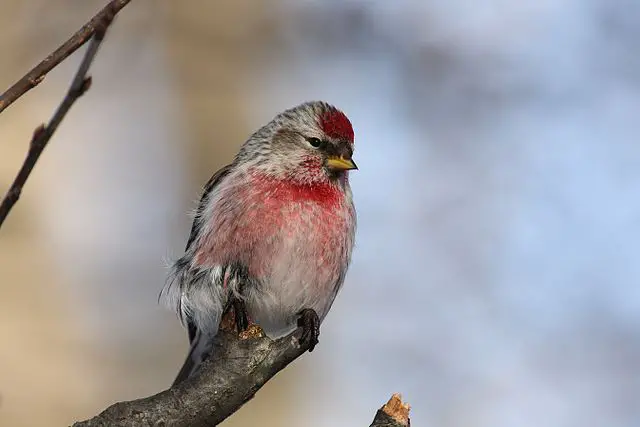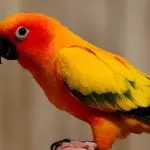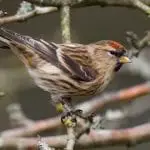Scientific Facts
| Common Name | Common redpoll |
| Scientific Name | Acanthis flammea |
| Lifespan | 12 Years |
| Size | 4.5 – 5.5 inches |
| Mass | 12 – 15 grams |
| Habitat | Artificial/ terrestrial, open woodlands, shrubland |
| Range | Northern Europe – Asia – northern North America |
Information and Physical Description
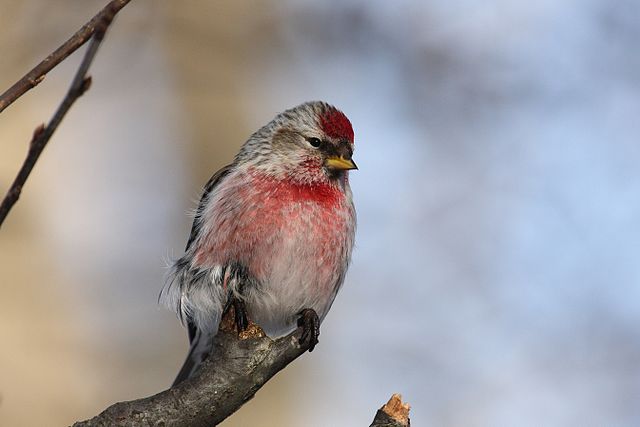
Back in time, the common redpoll was part of the genus Carduelis and used to be scientifically referred to as Carduelis flammea. However, based on molecular phylogenetic studies, both Arctic and common redpolls were then reclassified into the genus Acanthis, as these groups were shown to form a distinct lineage.
Nowadays, the common redpoll is scientifically referred to as Acanthis flammea and is placed in the order Passeriformes, family Fringillidae.
While the nominate species A. f. flammea is known to breed across the northern parts of North America, as well as Eurasia, the Icelandic subspecies A. f. islandica, aka the Icelandic redpoll, is known to breed in Iceland. There are two distinct populations that are united in , with the one being lighter and the one being darker, but the relationships between these two particular populations remain unresolved up-to-date.
The subspecies that breeds in Baffin Island and Greenland is called A. f. rostrata, aka the Greenland redpoll.
Altogether the Greenland and Iceland forms of the common redpoll are also referred to as “northwestern redpolls.”
According to most taxonomic authorities, the lesser redpoll (Carduelis cabaret), is considered a subspecific form of the common redpoll. Of all the redpolls, the lesser redpolls are the most streaked, the smallest, and also the brownest.
All forms of the common redpoll migrate south into Eurasia, northern USA, or Canada.The common redpoll is characterized by the presence of a bright red patch located on the forehead. This bird is a type of small finch colored in brownish-grey, and with dark streaks.
On the wings on common redpolls, two pale stripes, as well as a black bib, can be noticed.
Compared with the quite similar Arctic redpoll species, the common redpoll is smaller in size, more streaked, and generally browner.
As adults, these birds are known to measure between 4.5 – 5.5 inches, with an average mass of between 0.42 – 0.56 oz.A broad, dark brown streak runs across the vent, and the rump is also streaked. Common redpolls’ legs are brown in color, while the small, yellowish, pointed bills end with a dark tip. The irises of these birds are colored in dark brown.
The tail of Acanthis flammea is deeply notched and short. The chin is black, and the wing bars are white.
Apart from the distinct streaking on the underparts, common redpolls are characterized with a bright, vivid rosy red coloration that starts on the throat and breast zone, extending onto the cheeks.
Female common redpolls actually lack the mesmerizing rosy red coloration on the breast. Also, in females, the variable amount of streaking underneath is typically only confined to the sides of the body.
Before common redpolls turn one year of age, both males and females resemble the coloration of adult females, with the exception that the coloration of immature ones tends to be buffier.
Juvenile common redpolls are streaked and brown, gradually acquiring the red cap at some point during the late summer molt.
Arctic redpoll – Image Source
With the exact extent of interbreeding between hoary redpolls (Acanthis hornemanni, aka Arctic redpoll) and common redpolls remaining unknown up-to-date, it can be quite difficult to separate these birds at a mere glance. Adult male hoary redpolls are white below, while frosty white above, and the blush on the breast is only very pale pink.
Discerning between female and immature hoaryvs. common redpolls is even more complicated than discerning between adult males. The contemplator should rely heavily on being able to spot the differences in the shape and size of the bill, as well as the absence or presence of streaking on the rump, and nonetheless, the quality of striking on undertail coverts and on the flanks.
Other similar species include Pine Siskin, House Finch, Cassin’s finch, Purple finch, and American goldfinch.
Lifespan
The maximum recorded longevity of common redpolls in the wild is set at 12.2 years.
Although not verified at the time of this writing, it has been reported that these birds can live up to 25 years in captivity, given the proper care.
Ecosystem and Habitat
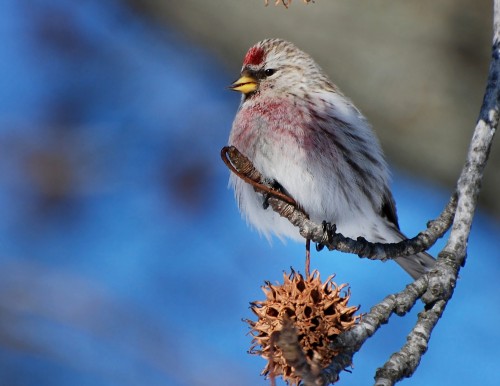
Common redpolls’ range extends through northern North America, Iceland, and Greenland to northern Europe and Asia.
Being partially migrant, these bids are known to move southward during the late autumn season, where they spend the winter before heading northward in March and April.
The typical natural habitat of common redpolls consists of boreal forests of larches, spruces, and pines.
There are two breeding subspecies of the common redpoll in North America, namely the small-billed and the smaller flammea. While both of these subspecies are widely spread across Alaska to Canada, they possess less coarse streaking than the common redpoll.
Found in Greenland and Baffin Island, the generally larger in size, large-billed rostrata is characterized by coarser streaking on the underneath of the body.
In the quintessentially treeless tundra, common redpolls are known to find shelters and hollows there where conifers or deciduous shrubs gain can possibly gain a foothold.
The winter range of common redpolls tends to be extremely variable, as these birds are on the search of quite unpredictable food sources, occurring in a diverse range of weedy and scrubby fields, open woodlands, and nonetheless, backyard feeders. These birds are also reported to live around towns.
Behavior
When it comes to the behavior of common redpolls, these birds have the reputation of being fairly busy, and impressively, curiously acrobatic small finches. They spend a big amount of their time feeding, flitting about, as well as engaged in calling using either their mournful dsooee call or their ceaseless che – che – che contact calls.
Further adding to the feeling of exuberant, incessant activity typical for common redpolls are the rolling feeding flocks that occur in the winter fields, as well as these birds’ bouncy flight.
In order to reach seeds that are located close to the very tips of thin, slim twigs, common redpolls often perform acrobatic moves. Apart from feeding amongst the foliage and branches of trees and shrubs, these birds also feed on weeds that grow close to the ground, or they feed directly on the ground.
These energetic little birds can be frequently spotted hanging upside down in the farthest tree branch’ tip. Their flying pattern is similar to that of many finches and is best described as an up-and-down, undulating pattern.
For the purpose of keeping their flocks in perfect order, common redpolls use several ways to indicate their intentions properly.
When a common redpoll is quarreling with other mates in the flock, the bird is to face its adversary, fluff its plumage, and open its bills, while also sometimes jutting the chin, thus, displaying the presumably fearsome black face patch.
When a male is to court a female, he is to fly in slow circles while further accompanying this form of a “love flight” with singing and calling.Also, during courtship, males may sometimes even feed females.
Even during the breeding season, small flocks of common redpolls can be observed. It is during migration when these birds may group up into thousands. Common redpolls are especially resistant to cold winter temperatures, and any winter movements are majorly driven by food availability rather than searching for warmer retreats.
It is not uncommon for small mixed groups of adults and juvenile common red poles and/or small groups solely consisting of juveniles to feed together sometimes.
A single flock can consist of more than 100 000 common redpolls, while the composition of the flock tends to vary, based on the sex and age proportions that change throughout the different times of the year.
At a good food source, it is possible for common redpolls to form mixed flocks containing yellowhammers and other species of finches.
Although evidence on regular internal migration is lacking, so movements are often considered irregular. However, experts have managed to find out that local movements are to occur as a seasonal response to food availability. To illustrate this better, many common redpolls that breed in the high country are to vacate during the cold winter season because of the rather scarce food available at high altitudes, which is why researches point out to the presence of an altitudinal component in many of the common redpolls’ movements.
Cool Facts
1. The number of common redpolls globally is estimated in the tens of millions!
2. Common redpolls are “equipped” with expandable throat poaches (aka esophageal diverticulum), where they can temporarily store seeds as needed. If desired, the bird can fill its pouch with delicious seeds before it quickly flies away in order to consume the seeds in a better protected, warmer spot. Also, common redpolls are capable of storing up to approximately 0.07 oz. of seeds (or about ¼ of their daily nutrition requirement) in their esophagus’ stretchy part.
3. Sometimes, common redpolls may choose to tunnel into the snow during the winter for the purpose of staying warm during the cold night. Common redpolls’ winter tunnels located under the insulating snow may reach more than 1.4ft. in length.
4. One of the common methods that animal behaviorists use when it comes to testing the intelligence of an animal is executed by attaching a piece of food onto a string so that the behaviorists can evaluate whether the animal is able to pull the string in order to get the hanging food item. Common redpolls are reported to pass this test excellently. In fact, they have been observed to intentionally shake the seeds out of birch tree catkins, until the seeds drop to the ground, and then the bird gets to pick them up.
5. According to some studies, it is possible that common redpolls subsist (almost) entirely feeding on birch seeds during the winter. Every day, these birds get to eat up to 42% of their own body mass!
6. Common redpolls are known to be able to survive extremely harsh temperatures during the winter season, and in particular, they can survive even when the temperatures drop to -67 degrees Fahrenheit. As compared to July, redpolls put on approximately 31% more plumage that helps to keep them warm even when temperatures are very low. Interestingly, the ability to fluff up their contour feathers as to trap layers of warm air is considered one of the unusual survival adaptations of these beautiful living creatures.
7. Even though limited in number, there are existing banding reports that show some common redpolls are amazingly wide-ranging. For example, a common redpoll banded in Michigan was found to recover all the way in Siberia! Another similar example is that of a redpoll banded in Alaska and then recovered in the eastern United States of America. Not the least, a redpoll once banded in Belgium was discovered in China 2 years later.
8. Common redpolls are active foragers, and just like their legendary energetic, electric zapping call reveals, they travel in rather busy flocks.
9. It was in 1758 when the common redpoll was first listed in the 10th edition of Systema Naturae by Linnaeus. Back then, common redpolls were listed under the scientific name Fringilla flammea.
10. The current scientific name for common redpoll – Acanthis flammea – consists of the ancient Greek word “akanthis,” which stands for a non-identifiable, small bird, while “flammea” is a word of Latin origin that translates into “flame-colored.”
11. The common redpoll’s song is described as a lengthy series consisting of twittering rattles and trills, while the flight call is described as a rattling, dry “jid jid jid jid.”
Reproduction
Common redpolls are most often observed either in pairs or as single individuals during the breeding season.
These birds breed from the middle of October until late in March. They breed in the far northern latitudes in open forests of alder, willow, birch, spruce, and pine located at about 5000ft. elevation.
Typically, redpolls produce a total of two clutches annually.
During the breeding season, males are known to defend a rather poorly-defined territory. Also, these birds are monogamous during the breeding season.
It is the female common redpoll’s duty to build a neat, small nest shaped like a cup, made out of fine twigs, tree moss, roots, and grass. The nest is further lined with a thick layer of Spruce grouse feathers, or with ptarmigan, or with wool, lemming fur, hair, or downy plant material. The nest’s outer layer is made out of thin twigs, while the middle layer consists of fragments of lichens, juniper bark, and root fibers. The inner layer is the softest and is made out of reindeer hair and willow buds.
The finished nest measures up to 4 inches across. The nest cup is approximately 2.5 inches in diameter vs. 2 inches in depth.
Although rarely, redpolls may re-use materials obtained from old nests. However, in most cases, they prefer to build a nest with fresh materials instead of re-using old ones.
Also, females are known to do most (if not all) of the search for suitable nest sites. Females choose to place their nests over thin horizontal branches of willow trees, spruces, or alders.
Nests are typically low to the ground. In the tundra, the nests are placed on rock edges or driftwood, among other possible low ground covers.
It is the male common redpoll’s task to feed his mate while she is engaged in incubating the clutch. Usually, the clutch consists of three and up to six speckled eggs, with four eggs being the most common number per clutch.
The eggs incubate for about 10 days.
Once the eggs hatch, the female and male common redpoll share parental care by feeding the young ones by regurgitation. This process proceeds until fledging, and for about two weeks later on.
At hatching, the immature redpolls weigh as little as about 1.3 grams. The young are to fledge in about thirteen days.
Both males and females reach sexual maturity once they turn 1 year of age.
Food and Diet
The major source of food in common redpolls’ diet is none other but smaller seeds that these birds glean from a wide variety of shrubs, trees, and weeds, such as Poa annua and toetoe grass seeds; dock, dandelion, rushes, Amaranthus, and fat hen seeds; mustard and buttercups wildflower seeds, alder, willow, spruce, pine and birch seeds.
Occasionally, Acanthis flammeaalso feed on berries.
Eaten mainly during the breeding season, the diet of common redpolls also includes a minor amount of small insects like aphids.In late winter, as well as in early spring, when the preferred food sources are usually not available, these birds are also known to consume buds.
Birch and alder seeds are most commonly taken while the birds are to hang upside down, “attacking” the cones or the seed heads.
At feeders, common redpolls will gladly feast on nyjer and/or millet and thistle seeds.
Housing
1. For the enthusiasts who want to attract common redpolls to their feeders, it is a must that food is changed regularly. Ultimately, food should be replaced every 2 days.
2. As a rule of thumb, common redpolls only eat seeds that are as small as to match these birds’ small bills.
3. One of the sure ways to attract common redpolls is to take advantage of niger seeds (aka nyjer) or thistle feeders. However, it is not uncommon for these birds to sometimes take black oil sunflower seeds. Also, they have been reported to possibly scavenge opened seeds that were left behind by other, larger-billed birds attending the feeder.
4. To stand the highest chances of attracting common redpolls to the feeder and enjoying the company of these birds to the fullest, make sure to offer some fresh niger seeds. Niger seeds are also known as Nyjer or thistle seeds. The seeds must be less than 3 months old. Also, the Niger seeds in the feeder should be best kept dry and loose.
5. It is a wise move to hang multiple feeders since common redpolls are extremely gregarious. The more finch feeders available, the more redpolls you can host and rejoice contemplating!
6. To grant yourself the utmost delight and privilege to watch more redpolls eating from the feeder, it is highly recommendable to make use of a mesh finch feeder. Although tube-type finch feeders will do an excellent job for attracting common redpolls, among other finches, mesh-type feeders will allow for more of these birds to eat at the same time, which makes up for attending a view that looks just like a busy beehive consisting of tens of fluffy, energetic, acrobatic, curios common redpolls!
Possible Health Issues
1. If one is to come across an injured common redpoll, please, do not attempt to treat or otherwise rescue the bird yourself prior to immediately reporting injured wildlife. Also, sick common redpolls may be noticed at one’s feeder, and in such cases, do mind that only federally licensed wildlife rehabilitators, as well as licensed veterinarians, can legally treat these wild birds, so do NOT attempt to take care of the bird by yourself, as this will almost certainly further compromise the health and well-being of the amazing living creature.
2. To minimize the possible risk of other birds getting infected in the case a sick common redpoll has been noticed in the feeder, clean the feeder area carefully and thoroughly immediately after reporting the sick bird by contacting a legal veterinarian/ wildlife rehabilitator.
3. If one is to notice more than just a single sick common redpoll in the feeder, all feeders must be taken down for at least 7 days in order to give the birds the chance to disperse. As a rule of thumb, the key to avoiding any possible disease from spreading is to always clean the feeders regularly, even if there seems to be no visible sign of any disease.
4. House Finch eye disease, also known as Mycoplasmal conjunctivitis, is caused by the Mycoplasma gallisepticum bacterium that has been known as a pathogen in chickens and turkeys for a long time back in the history of domesticated animals. However, ever since 1994, this disease has been also observed in several other species, such as the purple finch and the American goldfinch, among others. Even though data regarding House Finch eye disease in common redpolls are rather scarce, it is good to know that this disease is characterized by swollen, runny, red, and/or crusty eyes, with severe cases leading to the eyes becoming swollen shit, and the birds becoming blind.
5. Avian pox may affect common redpolls.
The first form of avian pox (the more common one) is characterized by abnormal, wart-like growths that appear around the eyes, on the legs and feet, and/or at the base of the bill, in general, on featherless areas of the bird’s body.
The second form of avian pox is characterized by plaques that develop on the mucous membrane of the trachea, throat, lungs, and mouth. It results in difficulty feeding and impaired breathing.
Several strains of poxvirus can cause avian pox, and this common disease has been reported in a minimum of 60 species of birds, including but not limited to owls, sparrows, and turkeys.
Do note that this virus can be spread by the ingestion of contaminated food and/or water by infected birds getting in direct contact with other birds and/or with contaminated areas, such as feeders.
6. Salmonellosis is an infection that can occur in common redpolls and is caused by a bacteria that is a part of the genus Salmonella. Unfortunately, it is often the case that symptoms of this bad condition are not always obvious, even though salmonellosis is one of the most common causes of mortality among feeder birds.
Sick birds may appear fat and rather fluffed up or exactly the opposite – thin. They may also have swollen eyelids. It is often the case that common redpolls or other feeder birds affected with salmonellosis are to be unusually easy to approach and rather lethargic.Remember that the primary ways of salmonellosis transmission include bird-to-bird contact and fecal contamination of water and food.
Since infected birds may not show any outward symptoms but are carriers of salmonellosis, therefore, spreading the infection to other feeder birds, with outbreaks of this particular disease having been reported to cause significant mortality in common redpolls, American goldfinch, and pine siskin, cleaning the feeder and the area around the feeder regularly is a must.
Availability – Where to Get One?
The possession of most wild birds is considered illegal, with the exclusive exception of people who happen to be under the direction of a person who has been licensed to take care of these birds.
Fortunately, it is fully legal to observe these creatures as much as one wishes to, although for those who live in North America it is only possible to see these beautiful creatures in the winter, as this is the time when they get to forage in weedy fields and/or on small seeds up in shrubs and trees.
In order to detect the presence of common redpolls in the wild, you want to keep your ear open for the buzzy, sharp call notes, as well as for the energetic chatters and trills. Also, note that these birds often form quite large flocks that seem to be in ceaseless, endless motion.In Europe, common redpolls used to be trapped for food and kept as cage birds back in time; however, these practices are becoming less common nowadays.
How to Take Care for a Common Redpoll?
In populated areas, common redpolls are known to possibly pass away as a result of salmonella infections at feeders. Furthermore, due to their flocking behavior, these birds can easily spread salmonellosis to other members of the flock. Because of this, in order to take the best care of these living creatures, make sure to keep the feeders, as well as the entire feeding area clean.Clean the feeders and the area beneath the feeders using a weak bleach solution that consists of 1 part bleach diluted in 9 parts of water.
Currently, it remains to yet be seen what climate changes may cause to common redpolls’ tundra and boreal habitat, although it should almost go without saying that changes in climate must be brought to a bare minimum if we want to make sure that we will be able to enjoy the healthy populations of stunning feathery companions in the future.
With all of the above being said, the best way to take proper care of these wild living beings is to embrace an environmental-friendly lifestyle. Also, as much as possible, don’t hesitate to spread awareness and to educate others about the collective responsibility that we, human beings, share when it comes to preserving the biodiversity and wildlife on the planet for generations to come.
During irruption years, when these beautiful finches migrate erratically, showing in fairly large numbers, they are known to frequently congregate bird feeders. This is the best time when one can be granted the wonderful chance to take a delightfully close look at these incredible wild creatures. Use your camera to take pictures and/or videos of these birds, and share them with friends, and why not with the rest of the world by using the power of global communication channels, so that more people across the planet will get to appreciate the beauty and wisdom that Mother Nature has embedded in common redpolls, among all other living creatures.
FAQ Section
What Does a Common Redpoll Look Like?
Adult male common redpolls possess a rosy red vest on the upper flanks and chest. All common redpolls are mainly colored in white and brown (two white wing bars and black feathering opposing the small yellow bill), with a red forehead patch, and their sides are heavily streaked.
Where Do Common Redpolls Come from?
Common redpolls,like all redpolls in general, are considerednorthern breedingspecies found in woodlands that mainly consist of birch and pine trees. Also, common redpolls have been successfully introduced in New Zealand, as well as in the nearby Subantarctic Islands.
What Do Common Redpolls Eat?
Common redpolls mainly eat seeds that are small enough to fit their bills, such as birch seeds, dandelion seeds, and thistle seeds, among others. They will also eat insects, such as spiders, exclusively during the breeding season.
Is the Common Redpoll a Finch?
Yes, the common redpoll is generally a small finch, also commonly referred to as one of the “winter finches” out there. These tiny, energetic, acrobatic, restless birds are known to actively feed on seeds, with their flocks consisting of tens of thousands seeming to be constantly on the move.
What Does it Mean to See a Finch?
In various Native American cultures, seeing a finch is associated with the symbolic spiritual power of the finch as a totem animal. The finch is believed to be a symbol of happiness, celebration, and joy, based on extensive observations of these birds’ behavior, songs, and colors.
Do Common Redpolls Migrate?
Common redpolls are known as irruptive migrants, moving south in winter (although irregularly), by following food availability patterns. Common redpolls usually come far south during the winter season, on a roughly 2-year cycle, and they may also occasionally reach the southern or central parts of the United States.
Are Common Redpolls Endangered?
According to the IUCN Red List of Threatened Species, common redpolls are classified as Least Concern as of 2019, since their populations remain steady, and in fact, widespread and abundant, at least as of now. What experts are not capable of predicting up-to-date, though, are the negative impacts associated with climate change, which can lead to significant declines in the populations of common redpolls in the foreseeable future, if adequate measurements are not taken on a personal and governmental level as soon as feasible.

